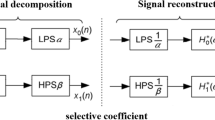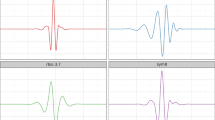Abstract
The complexities of the marine environment and the unique characteristics of underwater channels pose challenges in obtaining reliable signals underwater, necessitating the filtration of underwater acoustic noise. Herein, an underwater acoustic signal denoising method based on ensemble empirical mode decomposition (EEMD), correlation coefficient (CC), permutation entropy (PE), and wavelet threshold denoising (WTD) is proposed. Furthermore, simulation experiments are conducted using simulated and real underwater acoustic data. The experimental results reveal that the proposed denoising method outperforms other previous methods in terms of signal-to-noise ratio, root mean square error, and CC. The proposed method eliminates noise and retains valuable information in the signal.
Similar content being viewed by others
References
Bandt C, Pompe B (2002) Permutation entropy: A natural complexity measure for time series. Phys. Rev. Lett. 88(17): 1–4. https://doi.org/10.1103/PhysRevLett.88.174102
Chen R, Tang B, Lu Z (2012) Ensemble empirical mode decomposition denoising method based on correlation coefficients for vibration signal of rotor system. J. Vib. Measur. Diagnosis. 32(4): 542–546
Cheng X, Mao J, Li J, Zhao H, Zhou C, Gong X, Rao Z (2021) An EEMD-SVD-LWT algorithm for denoising a lidar signal. Measurement 168(3): 108405. DOI: https://doi.org/10.1016/j.measurement.2020.108405
Cui B, Chen X (2015) Improved hybrid filter for fiber optic gyroscope signal denoising based on EMD and forward linear prediction. Sens. Actuator A Phys. 230: 150–155. https://doi.org/10.1016/j.sna.2015.04.021
Du S, Liu T, Huang D, Li GL (2016) An optimal ensemble empirical mode decomposition method for vibration signal decomposition. Int. J. Acoust. Vib. 139: 1–18. https://doi.org/10.1115/L4035480
Gong Y, Tong Li Yu Z, Zhang X (2022) Research on fault diagnosis method of rotating machinery misalignment based on Pearson correlation coefficient. New Technology & New Products of China (5): 48–50. DOI: https://doi.org/10.13612/j.cnki.cntp.2022.05.013
Huang N, Shen Z, Long SR, Wu MC, Shih HH, Zheng Q, Yen NC, Tung CC, Liu HH (1998) The empirical mode decomposition method and the Hilbert spectrum for non-stationary time series analysis. Proc. R. Soc. A Lond. 454: 903–995
Islam MS, Chong U (2014) Noise reduction of continuous wave radar and pulse radar using matched filter and wavelets. J Image Video Proc 2014: 43. https://doi.org/10.1186/1687-5281-2014-43
Jia Y, Li G, Dong X, He K (2021) A novel denoising method for vibration signal of hob spindle based on EEMD and grey theory. Measurement 169: 108490. DOI: https://doi.org/10.1016/j.measurement.2020.108490
Li Q, Qin B, Si W, Wang R (2017a) Estimation algorithm for adaptive threshold of hybrid particle swarm optimization wavelet and its application in partial discharge signals denoising. High Voltage Engineering 43(5): 1485–1492. https://doi.org/10.13336/j.1003-6520.hve.20170428013
Li YX, Li YA, Chen X, Yu J (2017b) Denoising and feature extraction algorithms using NPE combined with VMD and their applications in ship-radiated noise. Symmetry 9(11): 256. https://doi.org/10.3390/sym9110256
Li YX, Li YA, Chen X, Yu J (2018a) Research on ship-radiated noise denoising using secondary variational mode decomposition and correlation coefficient. Sensors 18(1): 48. https://doi.org/10.3390/s18010048
Li YX, Li YA, Chen X, Yu J, Yang H, Wang L (2018b) A new underwater acoustic signal denoising technique based on CEEMDAN, mutual information, permutation entropy, and wavelet threshold Denoising. Entropy 20(8): 563
Lu W, Zhang L, Liang W, Yu X (2016) Research on a small-noise reduction method based on EMD and its application pipeline leakage detection. Loss Prev. Process Ind. 41: 282–293. https://doi.org/10.1016/j.jlp.2016.02.017
Ogundile OO, Usman AM, Versfeld J (2020) An empirical mode decomposition based hidden Markov model approach for detection of Bryde’s whale pulse calls. J. Acoust. Soc. Am. 147(2): EL125–EL131. https://doi.org/10.1121/10.0000717
Peng K, Guo H, Shang X (2021) EEMD and multiscale PCA-based signal denoising method and its application to seismic P-phase arrival picking. Sensors 21(16): 5271. https://doi.org/10.3390/s21165271
Qiao J (2016) The estimation of technical efficiency based on double-lag stochastic Frontier model. Statistics & Information Forum 31(11): 44–48. DOI: https://doi.org/10.3969/j.issn.1007-3116.2016.11.008
Rosenstein MT, Collins JJ, Luca CJD (1993) A practical method for calculating largest Lyapunov exponents from small data sets. Physica D 65: 117–134. https://doi.org/10.1016/0167-2789(93)90009-P
Santos-Domínguez D, Torres-Guijarro S, Cardenal-López A, Pena-Gimenez A (2016) ShipsEar: An underwater vessel noise database. Appl Acoust. 113: 64–69. DOI: https://doi.org/10.1016/j.apacoust.2016.06.008
Shang Z, Liu X, Liao X, Geng R, Gao M, Yun J (2019) Rolling bearing fault diagnosis method based on EEMD and GBDBN. Int. J. Performability Eng. 15(1): 230–240. DOI: https://doi.org/10.23940/ijpe.19.01.p23.230240
Shaw J, Wang YH, Lin CY (2016) Sound and vibration analysis of a marine diesel engine via reverse engineering. J Mar Sci Technol. 26(5): 1–9. https://doi.org/10.6119/JMST.201810_26(5).0009
Singh G, Kaur G, Kumar V (2014) ECG denoising using adaptive selection of IMFs through EMD and EEMD. International Conference on Data Science & Engineering, 228–231. DOI: https://doi.org/10.1109/ICDSE.2014.6974643
Sun Z, Xi X, Yuan C, Yang Y, Hua X (2020) Surface electromyography signal denoising via EEMD and improved wavelet thresholds. Math Biosci Eng. 17(6): 6945–6962. DOI: https://doi.org/10.3934/mbe.2020359
Tucker JD, Azimi-Sadjadi MR (2011) Coherence-based underwater target detection from multiple disparatesonar platforms. IEEE J. Ocean Eng. 36(1): 37–51. DOI: https://doi.org/10.1109/JOE.2010.2094230
Wang LB, Zhang XD, Wang XL (2013) Chaotic signal denoising method based on independent component analysis and empirical mode decomposition. Acta Phys. Sin. 62(5): 050201. https://doi.org/10.7498/aps.62.050201
Wang X, Xu J, Zhao Y (2018) Wavelet based denoising for the estimation of the state of charge for lithium-ion batteries. Energies 11(5): 1144. https://doi.org/10.3390/en11051144
Wess LG, Dixon TL (1997) Wavelet-based denoising of underwater acoustic signals. J. Acoust. Soc. Am. 101(1): 377–383. https://doi.org/10.1121/1.417983
Wu H, Huang NE (2011) Ensemble empirical mode decomposition: a noise-assisted data analysis method. Adv. Adapt Data Analysis 1: 1–41. https://doi.org/10.1142/S1793536909000047
Wu Z, Huang NE (2010) On the filtering properties of the empirical mode decomposition. Adv. Adapt Data Analysis 2(4): 397–414. https://doi.org/10.1142/S1793536910000604
Xiong Q, Xu Y, Peng Y, Zhang W, Li Y, Tang L (2017) Low-speed rolling bearing fault diagnosis based on EMD denoising and parameter estimate with alpha stable distribution. J. Mech. Sci. Technol. 31(4): 1587–1601. https://doi.org/10.1007/s12206-017-0306-y
Xue W, Dai X, Zhu J, Luo Y (2019) A noise suppression method of ground penetrating radar based on EEMD and permutation entropy. IEEE Geosci. Remote. Sens. Lett. 16(10): 1625–1639. DOI: https://doi.org/10.1109/LGRS.2019.2902123
Yang G, Liu Y, Wang Y, Zhu Z (2015) EMD interval thresholding denoising based on similarity measure to select relevant modes. Signal Process 109: 95–109. https://doi.org/10.1016/j.sigpro.2014.10.038
Yang H, Ning T, Zhang B, Yin X, Gao Z (2017) An adaptive denoising fault feature extraction method based on ensemble empirical mode decomposition and the correlation coefficient. Advances in Mechanical Engineering 9(4): 1–9. DOI: https://doi.org/10.1177/1687814017696448
Yue GD, Cui XS, Zou YY, Bai XT, Wu YH, Shi HT (2019) A Bayesian wavelet packet denoising criterion for mechanical signal with non-Gaussian characteristic. Measurement 138: 702–712. https://doi.org/10.1016/j.measurement.2019.02.066
Zanin M, Gómez-Andrés D, Pulido-Valdeolivas I, Martín-Gonzalo JA, López-López J, Pascual-Pascual SI, Rausell E (2018) Characterizing normal and pathological gait through permutation entropy. Entropy 20(1): 77. https://doi.org/10.3390/e20010077
Zhang W, Zheng X, Yang R, Han J (2017) Research on identification technology of ship radiated noise and marine biological noise. IEEE International Conference on Signal Processing, Communications and Computing 3: 3142–5386. DOI: https://doi.org/10.1109/ICSPCC.2017.8242384
Zhang XL, Cao LY, Chen Y, Jia RS, Lu XM (2022) Microseismic signal denoising by combining variational mode decomposition with permutation entropy. Applied Geophysics 19(1): 65–80. https://doi.org/10.1007/s11770-022-0926-6
Zhao XJ (2015) Research on the correlation and complexity of time series. PhD thesis, Beijing Jiaotong University, Beijing. DOI: https://doi.org/10.7666/d.Y2917148
Zhao Z, Liu J, Wang S (2011) Denoising ECG signal based on ensemble empirical mode decomposition. International Symposium on Signal Processing and Information Technology 23: 170–177. DOI: https://doi.org/10.1109/ISSPIT.2017.8388665
Funding
Funding Supported by the National Natural Science Foundation of China (No. 62033011), and Science and Technology Project of Hebei Province (No. 216Z1704G, No. 20310401D).
Author information
Authors and Affiliations
Corresponding author
Ethics declarations
Competing interest The authors have no competing interests to declare that are relevant to the content of this article.
Additional information
Article Highlights
• This study mitigates partial loss in traditional denoising by combining denoising with PE and WTD, leveraging EEMD.
• PE segregates noise into pure and noise-dominant components, preserving effective signals through targeted denoising of the noise-dominant component.
• The method efficiently removes noise, eliminating local prominent peaks in the signal for a smoother and refined final output.
Rights and permissions
About this article
Cite this article
Zhang, Y., Yang, Z., Du, X. et al. A New Method for Denoising Underwater Acoustic Signals Based on EEMD, Correlation Coefficient, Permutation Entropy, and Wavelet Threshold Denoising. J. Marine. Sci. Appl. 23, 222–237 (2024). https://doi.org/10.1007/s11804-024-00386-6
Received:
Accepted:
Published:
Issue Date:
DOI: https://doi.org/10.1007/s11804-024-00386-6




